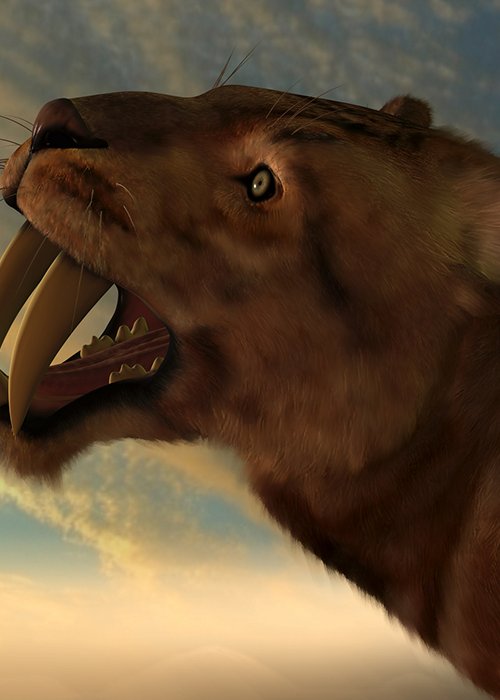A remarkable discovery has recently sparked global interest: a sabre-toothed tiger cub, estimated to be around 35,000 years old, was found perfectly preserved in Siberian ice. This find thrilled the scientific community and palaeontology enthusiasts alike, offering a rare glimpse into one of prehistory’s most fascinating and fearsome creatures. But what exactly do we know about these mysterious sabre-toothed tigers and the story of this frozen cub?
Sabre-toothed tigers, scientifically known as Smilodon, were among the best-known predators of the Pleistocene, living between 2.5 million and 10,000 years ago. These big cats could reach 2.5 metres in length and weigh over 300 kg. Their iconic sabre-like teeth, which could grow up to 20 cm long, weren’t used to tear flesh, as could be expected, but to deliver fatal blows to prey by targeting the throat. They had powerful, muscular builds, perfectly suited for hunting in wild environments with prey like mammoths, bison, and other large herbivores.
The cub found in the Siberian permafrost is an exceptionally rare and valuable specimen. Not only is it incredibly well-preserved, but it is also very young, likely just 6 to 8 months old. Its small size makes it even more interesting, offering a unique opportunity to study the growth and development of this rare species. The cub’s fur and skin are surprisingly intact, allowing scientists to gather detailed information about its biology and diet. One particularly fascinating feature is its teeth: the cub had already developed prominent canines, though not fully grown, clearly showing the species’ characteristic sabre structure. This provided valuable insight into how these predators may have used their teeth in hunting, even at a young age. The cub was found in a remote region of Siberia, one of the coldest and harshest places on Earth. These extreme environmental conditions played a crucial role in preserving the cub’s body, which remained frozen in ice for millennia. Siberia is well-known for its palaeontological discoveries, as the freezing temperatures and permafrost deposits preserve ancient remains with extraordinary effectiveness.
The cause of the cub’s premature death is still under investigation. However, permafrost conditions have enabled scientists to carry out precise analyses, such as DNA testing and health assessments. So, what led to the extinction of this species? Sabre-toothed tigers disappeared around 10,000 years ago, at the end of the last Ice Age. The exact cause remains debated, but several theories exist. The most widely accepted suggests a combination of drastic climate changes and a decline in prey contributed to their extinction. As the Ice Age ended and global temperatures rose, many large prey animals - like mammoths and bison - began to die out. But how was the cub found? It was discovered during a palaeontological expedition exploring a known site for prehistoric remains. During an excavation campaign, researchers came across what initially looked like a block of ice, but it soon revealed the outline of a well-preserved cub, immediately drawing expert attention.
The idea of de-extinction - bringing extinct species back to life through genetic engineering - has been discussed in recent years. However, in the case of the sabre-toothed tiger, it has not been seriously pursued. Even though well-preserved remains allow scientists to extract DNA and study it, de-extinction of an animal like Smilodon would raise huge ethical challenges. It would require not only perfectly preserved DNA but also the recreation of habitats and ecological conditions from millions of years ago. Moreover, introducing an extinct species into today’s ecosystem could pose numerous risks. The disappearance of sabre-toothed tigers, like that of many other prehistoric species, offers valuable lessons for the extinction of animals today. The primary causes of modern extinction, such as climate change, mirror the dynamics that led to the sabre-toothed tiger’s demise. Today, human activities are having a devastating impact on ecosystems and the species that depend on them. In conclusion, the discovery of the sabre-toothed tiger cub is not only a breakthrough in understanding prehistory but also a powerful reminder for our future. It invites us to reflect on the fragility of species and the importance of preserving their habitats, before it’s too late.
By Caterina Vicino and Camilla Simoni, Liceo Scientifico Vittorio Veneto, Milan




